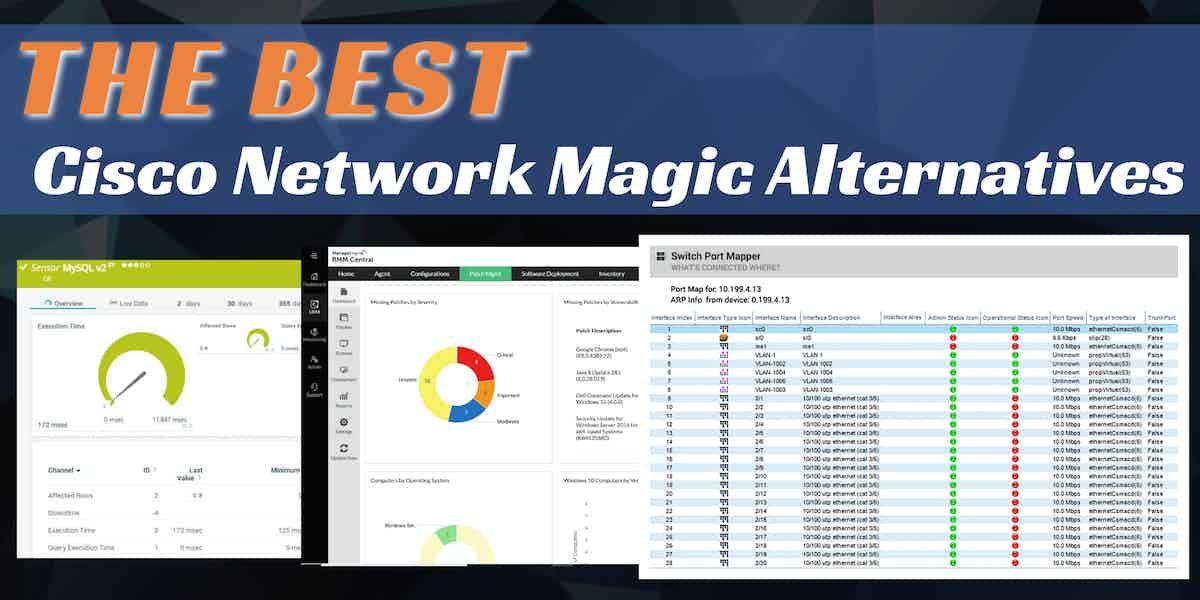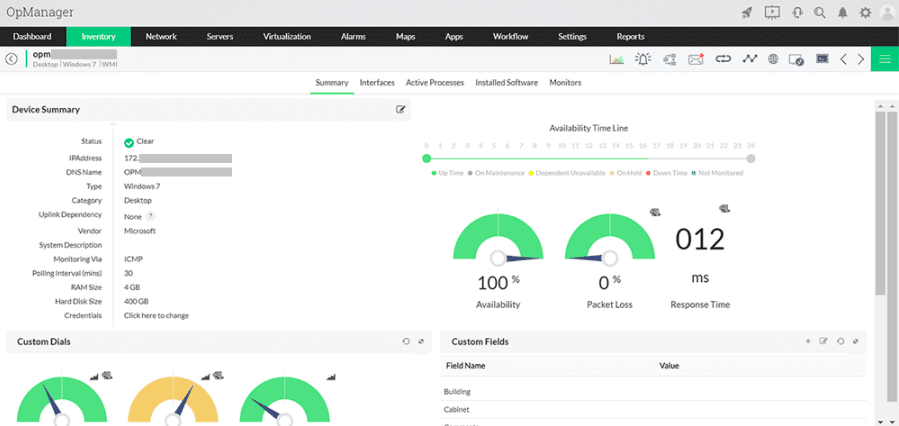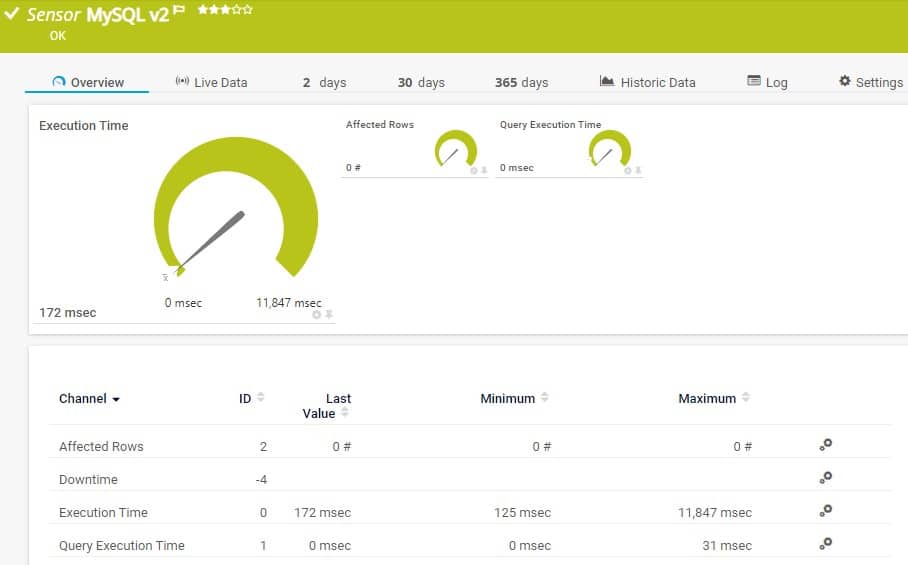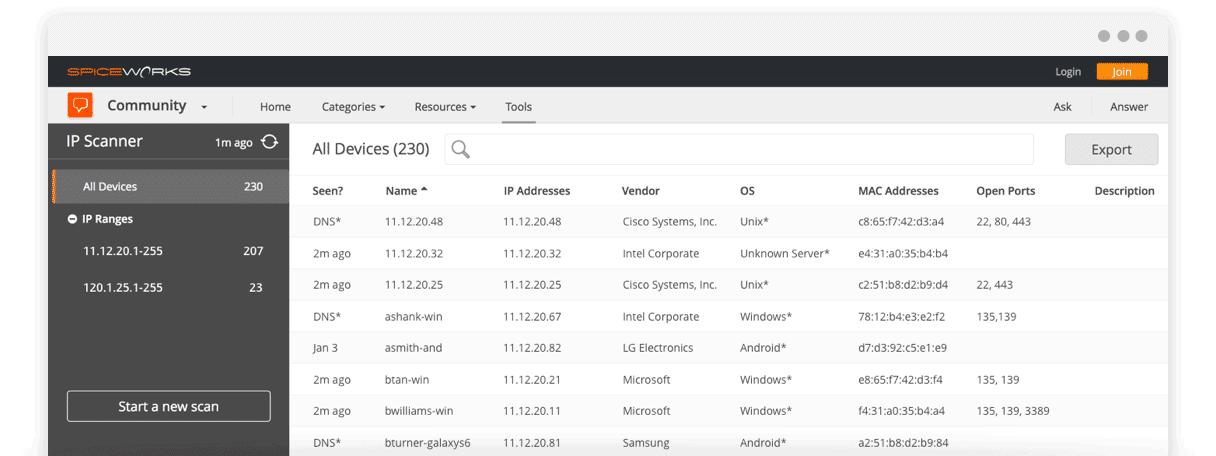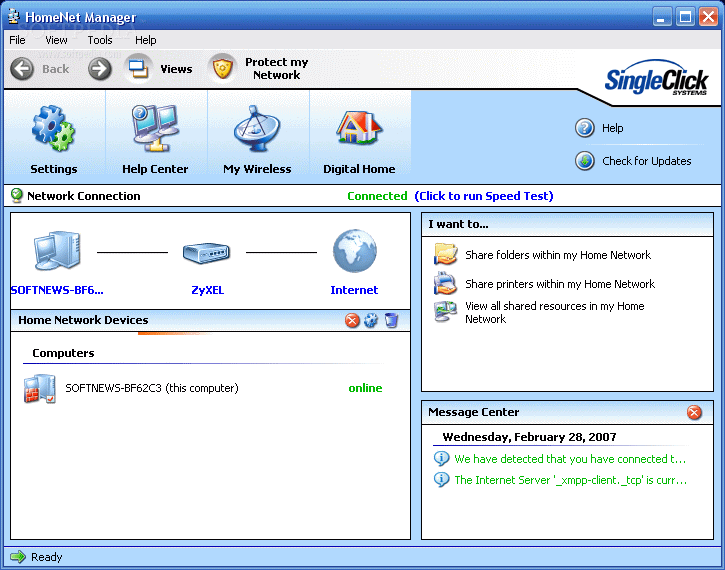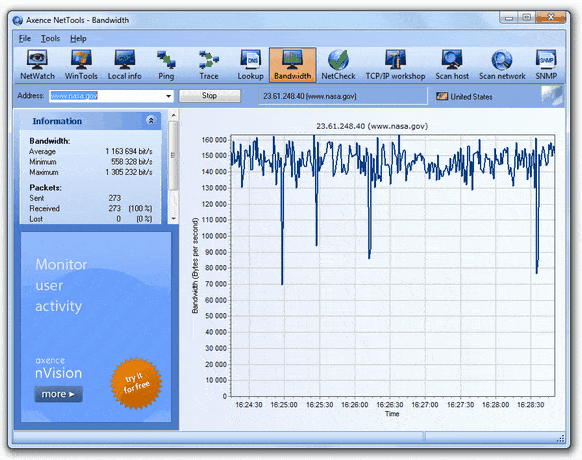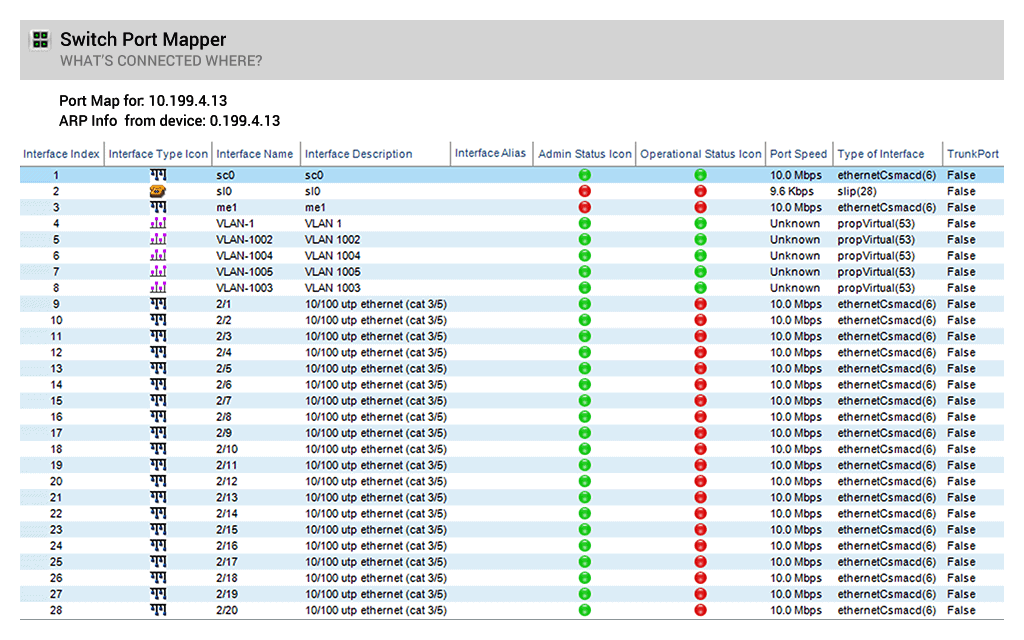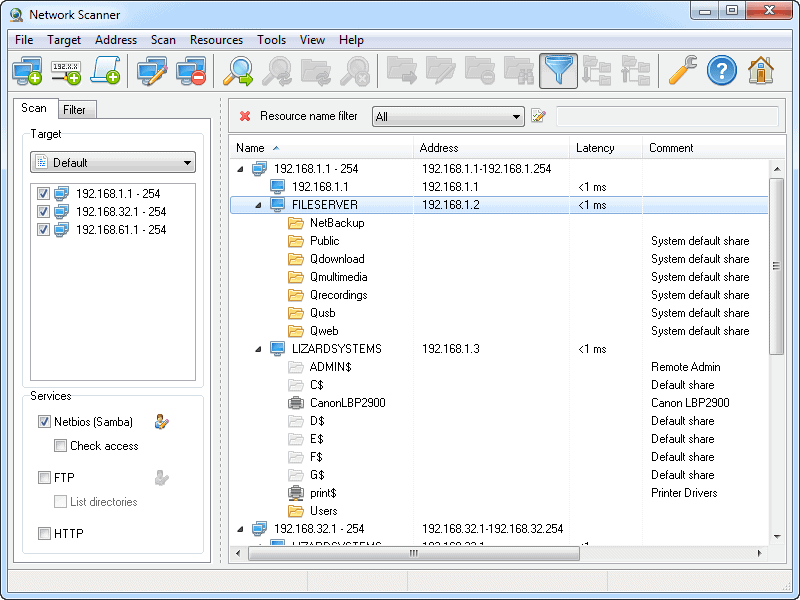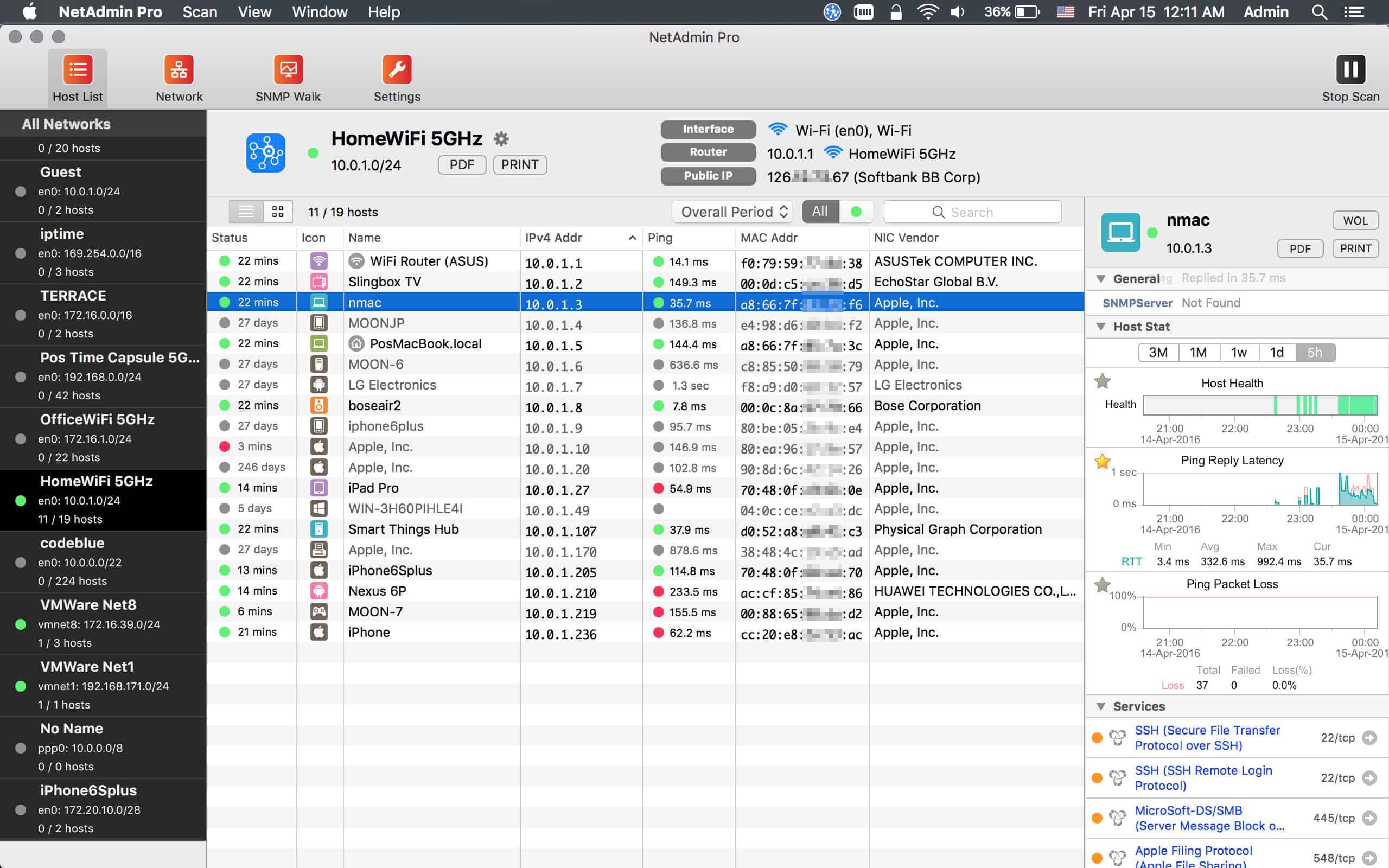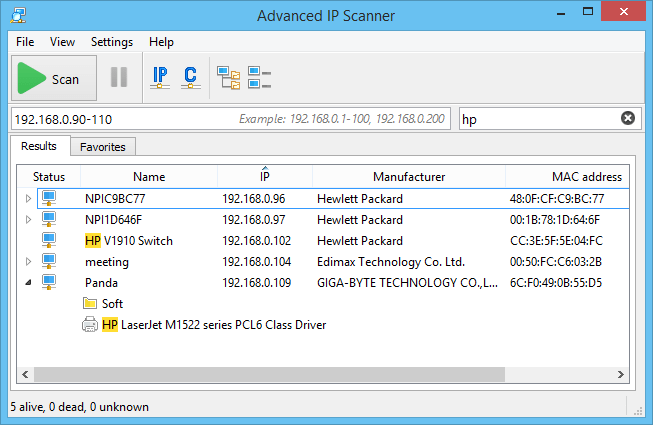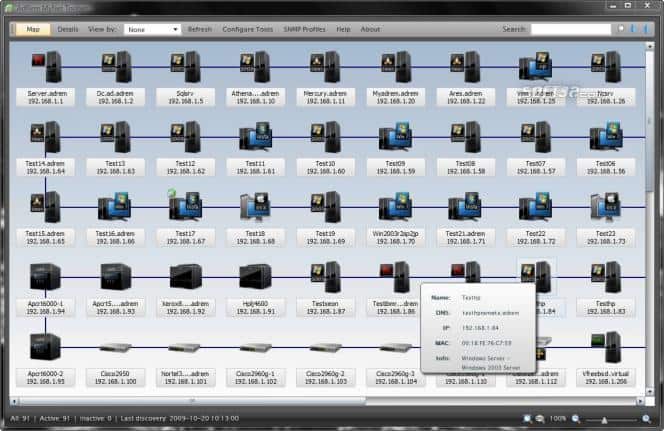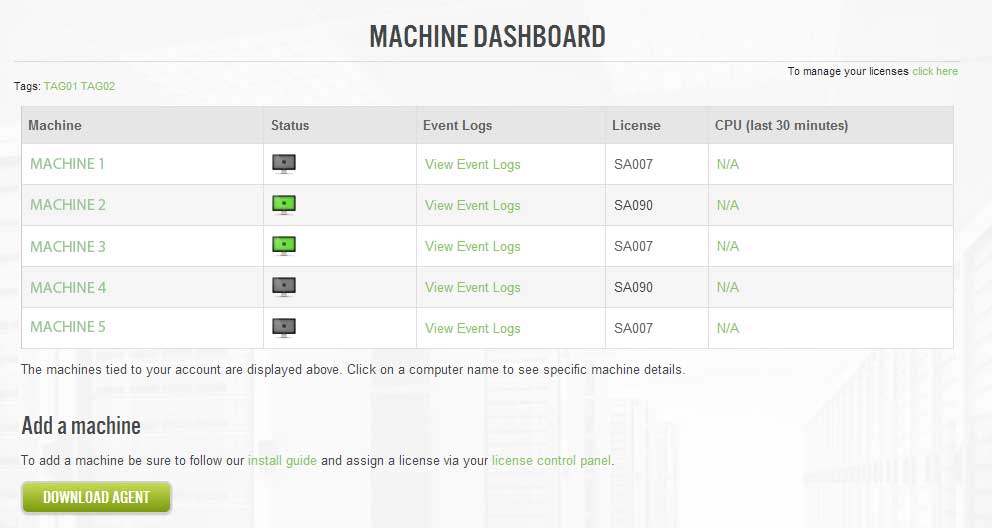Monitoring and managing computers are integral for IT administration and security, but it can be time-consuming and even overwhelming for a team of IT admins to handle an entire organization’s devices. This is why many automation tools were developed, and one of the most widely-used among them is Cisco’s Network Magic.
Here is our list of the best Network Magic Alternatives:
- Atera – EDITOR’S CHOICE This cloud-based platform offers advanced remote monitoring, automated management, customizable reporting, and real-time alerts, providing comprehensive network management for IT professionals and Managed Service Providers. Get a 30-day free trial.
- ManageEngine OpManager – FREE TRIAL Real-time monitoring and automated network mapping provide comprehensive network management, making it one of the best alternatives to Cisco Network Magic. Download a 30-day free trial.
- Paessler PRTG Network Monitor – FREE TRIAL Complete solution that can be customized to meet your preferences and at the same time, helps to stay on top of your infrastructure’s performance and issues. Download a 30-day free trial.
- Spiceworks IP Scanner Cloud-based tool that scans the local network to discover devices and gather information about each of them.
- HomeNet Manager Ideal for configuring and managing home and small corporate networks.
- Atera Remote monitoring and management tool for managed service providers.
- Axence NetTools Set of ten tools to scan and monitor networks and provide diagnostic information about the devices.
- SolarWinds Engineer’s Toolset Comprehensive toolset that comes with 60 different tools to monitor different metrics for easy troubleshooting.
- LizardSystems Network Scanner Handy tool for scanning networks of all sizes.
- NetAdmin Pro Network monitoring tool designed for macOS, though it also works on Windows and Linux.
- Advanced IP Scanner Free and reliable tool for analyzing LAN devices.
- AdRem Mynet Toolset Reliable network diagnostic and troubleshooting tool.
- Network Assistant Real-time communication utility for monitoring devices in a network.
- SentinelAgent Cloud-based Windows monitoring solution that provides detailed metrics.
While Network Magic was an effective way to stay on top of computers and devices, it is no longer supported because, in 2012, Linksys (owned by Cisco then) introduced its smart Wi-Fi routers that included a lot of Network Magic’s functionality. Since then, no new updates have been made to Network Magic and this has made it obsolete in today’s world.
This lack of updates to Network Magic led to the development of many alternatives. We’ll review the best alternatives to Network Magic in this article to help you pick the right one that best suits your needs.
Related Post: Best Cisco Monitoring Software
Our methodology for selecting the Best Cisco Network Magic Alternatives
We’ve broken down our analysis for you based on these key criteria:
- Comprehensive network monitoring capabilities that cover various aspects like bandwidth usage, CPU load, and temperature monitoring.
- Troubleshooting tools for identifying and resolving network issues effectively.
- Configuration management tools for routers and switches.
- Features for automatic network device discovery and diagnostics.
- User-friendly interface with real-time analytics and reporting.
The Best Cisco Network Magic Alternatives
Let’s look at each of these alternatives in-depth to help you make an informed choice.
1. Atera – FREE TRIAL
Atera is a remote monitoring and management tool that’s more suited for managed service providers to help them meet the service level agreements with their clients.
Key Features:
- Provides complete visibility and control for any-sized network
- Built-in remote monitoring software to address issues right away
- Supports real-time monitoring and sends alerts accordingly
- Monitors many aspects such as system resources, Windows updates, SQL server, SNMP-enabled devices, network, IP monitoring, and more
- Includes preconfigured maintenance tasks that can be applied quickly to devices
- Automates patch management
- Remote management tools that help you run scripts, uninstall software, install updates, and run any command
- Integrated Splashtop to provide instant support to customers
Why do we recommend it?
After installing Atera and testing its functionalities, we were especially impressed by its comprehensive remote monitoring software. We put its real-time monitoring and alert system to the test, and it consistently delivered accurate and timely updates. Additionally, the preconfigured maintenance tasks proved to be a significant time-saver, allowing for swift application to various devices.
Who is it recommended for?
Atera is ideal for managed service providers aiming to uphold their service level agreements and deliver impeccable service to their clients. Organizations that require a robust tool for real-time monitoring, coupled with a suite of remote management tools, will find Atera to be invaluable.
Pros:
- Extensive remote monitoring and management
- An integrated ticketing system for tracking and managing service requests
- Sends instant alerts for any issues, allowing prompt resolution to avoid downtime
- Automatically discovers devices within the network for easier management and monitoring
- Built-in software for immediate issue resolution
- Preconfigured maintenance tasks for efficiency
- Integrated Splashtop for instant customer support
Cons:
- Additional costs for certain add-ons.
Atera offers three pricing plans:
- Pro: $99 per technician
- Growth: $129 per technician
- Power: $169 per technician
Besides the plans, you can also include add-ons at any time. The Network Discovery add-on is priced at $29 per technician and the Work from Home via Splashtop integration costs $5/month per computer with remote access. You can get started with a 30-day free trial.
EDITOR'S CHOICE
Atera is our top pick for a Cisco Network Magic alternative because it offers a more comprehensive and scalable network management solution designed for modern IT needs. While Cisco Network Magic provides basic network management and device monitoring, Atera takes it a step further by integrating remote monitoring and management (RMM) with automation, real-time alerts, and customizable reporting, making it ideal for Managed Service Providers (MSPs) and IT professionals managing complex networks. Atera’s cloud-based platform allows for centralized management, meaning users can monitor and manage network devices from anywhere. This is a significant advantage over Cisco Network Magic, which requires on-premises installations. Atera provides deeper insights into network performance, with features like network discovery, asset management, and detailed reporting, enabling better decision-making and resource allocation. The platform also supports automation, reducing the need for manual intervention in routine tasks like patch management and software updates, leading to improved efficiency and uptime. Atera’s multi-platform support, including Windows, macOS, and Linux, ensures compatibility across diverse environments.
Download: Get a 30-day FREE Trial
Official Site: https://www.atera.com/signup/
OS: Cloud-based
2. ManageEngine OpManager – FREE TRIAL
ManageEngine OpManager is an essential tool for monitoring Cisco network devices, ensuring proactive identification of issues and minimizing downtime.
With networks being the backbone of today’s business operations, even a few minutes of downtime can be detrimental. OpManager offers comprehensive Cisco device monitoring through data collection, threshold verification, and fault notification. It supports a wide range of Cisco devices including Nexus, ASR, and Catalyst series via SNMP and CLI protocols, and Cisco UCS via UCS Manager API.
Key Features:
- Real-Time Monitoring: Provides immediate insights into network performance and health, ensuring prompt detection and resolution of issues.
- Comprehensive Device Support: Supports a wide range of devices, including routers, switches, firewalls, and servers, for versatile network management.
- Automated Network Mapping: Automatically discovers and maps your entire network, giving you a clear overview of your network topology.
- Threshold-Based Alerts: Customizable alerts notify you of any performance issues, helping you take proactive measures.
- Detailed Reporting: Generates comprehensive reports on network performance, utilization, and health for informed decision-making.
- User-Friendly Dashboard: Centralized dashboard provides an easy-to-navigate interface for monitoring and managing network devices.
- Integrated Troubleshooting Tools: Includes tools for diagnosing and resolving network issues, reducing downtime and improving efficiency.
Why do we recommend it?
ManageEngine OpManager is a robust network management solution that serves as an effective alternative to Cisco’s Network Magic. It offers comprehensive monitoring capabilities, including real-time visibility into network performance, traffic, and errors across various devices such as routers, switches, firewalls, and servers. The platform’s user-friendly interface and customizable dashboards enhance operational efficiency, making it a valuable tool for network administrators.
By periodically monitoring these devices and cross-verifying against set thresholds, OpManager automatically notifies technicians and network admins of any faults via email and SMS. This proactive approach helps in identifying and resolving issues before they impact business operations, making it the best alternative to Cisco Network Magic.
Who is it recommended for?
OpManager is ideal for IT professionals and organizations seeking a cost-effective and scalable network monitoring solution. Its extensive support for diverse network devices and protocols makes it suitable for businesses of all sizes, particularly those looking to replace or upgrade from legacy tools like Network Magic.
Pros:
- Comprehensive Monitoring: Provides real-time monitoring of network devices, offering insights into performance metrics such as latency, packet loss, and bandwidth utilization.
- User-Friendly Interface: Features an intuitive and customizable dashboard that simplifies navigation and enhances user experience.
- Scalability: Capable of scaling to accommodate growing network infrastructures, making it suitable for both small businesses and large enterprises.
- Cost-Effective: Offers a range of features at a competitive price point, delivering good value for the investment.
Cons:
- Learning Curve: Advanced features may require time to master, potentially necessitating additional training for some users.
Access a 30-day free trial download.
3. Paessler PRTG Network Monitor – FREE TRIAL
Paessler PRTG Network Monitor is a complete solution to stay on top of your infrastructure issues. It is ideal for businesses of all sizes and is cost-effective as well.
Key Features:
- Monitors the entire infrastructure including network, devices, switches, and more.
- Supports all the popular technologies like SNMP, WMI, SSH, HTTP, Ping, SQL, etc.
- Visualizes network using real-time maps
- Creates a dashboard of all your devices using a map designer that uses more than 300 map objects to represent different devices.
- Integrates all network components
- Sends alerts in the event of unusual metrics
- Allows you to customize notifications with its PRTG API
- Works well on many devices such as laptops and mobile devices (both iOS and Android)
- Includes an automatic single failover in every PRTG on-prem license
- Supports distributed monitoring
- Generates in-depth reports
- Monitors everything including IoT, cloud services, packet loss, application monitoring, and more.
Why do we recommend it?
After installing the free trial of Paessler PRTG Network Monitor, we were thoroughly impressed by its comprehensive infrastructure monitoring capabilities. We specifically tested its real-time map visualization and found it to be both intuitive and detailed, allowing for efficient network management.
PRTG is a sensor-based product, so the cost depends on the number of sensors you use. A sensor is a single aspect that you monitor on a single device. For example, if you monitor the CPU load and bandwidth consumption on a device, then it counts as two sensors.
Who is it recommended for?
Paessler PRTG Network Monitor is ideal for businesses and IT professionals seeking a holistic view of their network infrastructure. Its support for popular technologies like SNMP, WMI, and SSH makes it a versatile tool for a wide range of users. Companies that prioritize real-time data visualization, especially with a need for customized notifications and distributed monitoring, will find this tool particularly beneficial. Additionally, those managing IoT devices or cloud services will appreciate its in-depth monitoring features.
Pros:
- Comprehensive infrastructure monitoring.
- Supports major technologies like SNMP, WMI.
- Customizable real-time maps and dashboards.
- In-depth reporting and distributed monitoring.
Cons:
- Cost scales with sensor use.
The available packages are:
- PRTG 500 – Costs $1,750 and supports 500 sensors and one server installation
- PRTG 1000 – Costs $3,200 and supports 1000 sensors and one server installation
- PRTG 2500 – Costs $6,500 and supports 2500 sensors and one server installation
- PRTG 5000 – Costs $11,500 and supports 5000 sensors and one server installation
- PRTG XL1 – Costs $15,500 and supports unlimited sensors and one server installation
- PRTG Enterprise – Custom pricing based on your needs
There is a 30-day free trial of the unlimited version. After 30 days, it reverts to the free version that comes with 100 sensors. You have to upgrade to a paid package to use more sensors.
4. Spiceworks IP Scanner
Spiceworks IP Scanner is a cloud-based tool that scans the local network, discovers all the devices with an IP range, and provides detailed hardware and software info about each.
Key Features:
- Discovers devices on your network automatically
- Provides detailed hardware and software information on every device including CPU, storage, memory, etc.
- Allows you to sort through the list of devices, customize the IP range, and deploy agents in your network
- Add agents to your devices to get in-depth information
- Document your IT devices easier
- Scans your network for unknown devices and reports the same
- Identifies security loopholes quickly
Why do we recommend it?
We decided to test Spiceworks IP Scanner’s claim of detailed hardware and software information retrieval. After downloading and navigating its cloud-based interface, we found its automatic device discovery to be incredibly efficient. Additionally, the tool’s ability to quickly identify security loopholes stood out during our sandbox environment testing.
Who is it recommended for?
Spiceworks IP Scanner is a go-to for IT professionals and network administrators aiming for a seamless overview of their local network’s devices. Its capabilities cater especially to those who require detailed hardware and software insights or have a need to regularly document IT devices. Companies or individuals concerned about security and wish to detect unknown devices or potential vulnerabilities in their network swiftly will find this tool invaluable.
Pros:
- Automatically discovers network devices
- Provides detailed hardware/software info
- Customizable device sorting and IP range
- Quick identification of security loopholes
Cons:
- Limited functionality compared to other tools
- May require additional agents for in-depth info.
Pricing: There are four plans to choose from and they are:
- Individual
- Team
- Enterprise
- Custom
The price for each of these plans depends on the number of devices and users. Click here to try the Spiceworks IP Scanner.
5. HomeNet Manager
As the name suggests, HomeNet Manager is a tool that helps to configure and manage your home network, especially when you want to optimize your bandwidth usage. This is also a neat tool to design your home network from scratch.
Key Features:
- Analyzes the devices on your network and displays them graphically for a better understanding of their status
- Configure the shared folders for your computer, view the IP address for each device, alter the router configuration, and more
- Displays the shared resources and files
- Intruder Protection feature that detects and stops any hacker from entering your network
- Displays the name and IP address of your ISP
- Designs an optimal home or office network for you, depending on your needs
- Works well on all Windows devices and versions
Why do we recommend it?
We downloaded and installed HomeNet Manager to test its capabilities in designing and managing home networks. One feature that particularly caught our attention was its graphical representation of devices on the network, making it easier to understand their status. The Intruder Protection feature lived up to its promise, effectively identifying and preventing unauthorized access during our testing phase.
Who is it recommended for?
HomeNet Manager is perfect for homeowners and small office setups looking to set up, optimize, or secure their network. Those who prefer a visual representation of their devices for easy management will find it especially useful. However, for a modern Cisco Network alternative, we found the interface a bit dated.
Pros:
- Ideal for home network management
- Graphical display of network devices
- Intruder Protection feature enhances security
- Optimizes bandwidth usage effectively
Cons:
- Limited to Windows devices and versions
Though it was developed by SingleClick Systems, you can download it from CNET or FindMySoft for free.
6. Axence NetTools
Axence NetTools is a set of ten tools that scans and monitors networks and provides the associated diagnostics. It works well for both home and commercial use. The ten tools are Axence NetWatch, Portscan, WinTools, SNMP, Traceroute, NetStat, Local Info, Lookup, Bandwidth, and NetCheck.
Key Features:
- Monitors the response time and availability of multiple hosts
- Sends notifications through email, message, or sound
- Tracks the percentage of lost packets for HTTP, POP3, SMTP, FTP, SFTP, and other protocols
- Generates current and historical charts to help you understand the percentage of lost packets
- You can export data to XML, HTML, and TXT formats
- Supports TLS/SSL protocols as well
- Scans networks, ports, and services to identify open ports and the services running on each discovered device
Why do we recommend it?
Upon installing and navigating Axence NetTools, we were drawn to its comprehensive set of ten distinct tools, each catering to a specific network diagnostic need. We particularly tested the Axence NetWatch and Bandwidth tools, and found them to provide precise response times and detailed bandwidth metrics, respectively.
Who is it recommended for?
Axence NetTools is a versatile choice suitable for both home users aiming to optimize their network performance, and businesses seeking comprehensive network diagnostics. Its diverse toolset makes it a favorable choice for IT professionals and network administrators wanting a deep dive into network metrics. The free pricing model, coupled with its capability to export data in multiple formats, further makes it a viable option for budget-conscious users without compromising on functionality.
Pros:
- Comprehensive set of ten network tools.
- Detailed packet loss tracking for multiple protocols.
- Efficient network and service scanning.
- Free personal license available.
Cons:
- Limited TLS/SSL protocol support.
Click here to download Axence NetTools for free.
7. SolarWinds Engineer’s Toolset
SolarWinds Engineer’s Toolset is a network monitoring tool that comes with more than 60 tools to handle the different functionalities offered by Network Magic and more. This comprehensive tool from SolarWinds is undoubtedly a popular choice for Network Magic lovers.
KeyFeatures:
- Monitor bandwidth usage in real-time
- Troubleshoot network issues
- Access configuration management tools for your router or switch
- Understand the current CPU load
- Monitors CPU temperature
- Locate DNS errors in the database
- Analyze memory utilization in real-time
- Network diagnostics
- Understand the status of ports
- Perform network stress tests, DNS-based Blackhole List checks, and more
- Automatically discover network devices
Why do we recommend it?
After installing and exploring the SolarWinds Engineer’s Toolset, we were impresed by its comprehensive suite of over 60 tools, which effectively covered a vast array of network functionalities. Its real-time bandwidth and memory utilization monitoring, combined with its troubleshooting and diagnostic capabilities, made it a standout solution for any sysadmin or tech.
Who is it recommended for?
SolarWinds Engineer’s Toolset is an excellent fit for network administrators and IT professionals who are seeking an all-inclusive network monitoring tool. Its features, such as real-time monitoring, configuration management, and network diagnostics, make it ideal for those who need to maintain, troubleshoot, and optimize their networks efficiently. Furthermore, individuals who appreciated Network Magic will find this tool a robust and expanded alternative.
Pros:
- Over 60 diverse network tools.
- Real-time bandwidth monitoring.
- Efficient troubleshooting capabilities.
- Automatic network device discovery.
Cons:
- Pricing higher than some competitors.
Pricing starts at $1,585. Click here for a fully functional 14-day free trial.
8. LizardSystems Network Scanner
LizardSystems Network Scanner is a handy tool for scanning both large networks with thousands of devices and home networks with just a couple of computers. This scanner discovers devices and shared and web resources, as well as checking access rights for each of them.
Key Features:
- Simple and easy-to-use interface
- Multithreaded scanning process to can scan thousands of computers every minute
- Scaleable scaled up or down to meet your needs
- Filter the results using many parameters
- Checks the status and availability of a device using ping or with connection to the ports
- Scans FTP and web servers as well
- No admin privileges are needed for scanning
- Exports results to different file formats such as HTML, XML, or txt
Why do we recommend it?
We decided to delve into LizardSystems Network Scanner’s claim of scalability and its ability to handle both small and large networks. After installation, we were pleasantly surprised by its multithreaded scanning process, which showcased impressive speeds, even when scanning larger networks.
Who is it recommended for?
LizardSystems Network Scanner is an excellent choice for IT professionals and organizations of varying sizes – from those managing vast networks with thousands of devices to individuals overseeing their home networks. Its simple interface makes it accessible even for users with limited technical know-how.
Pros:
- Efficient for both large and small networks
- Simple, user-friendly interface
- Advanced scanning with multiple parameter filters
- No admin privileges needed for scanning
Cons:
- Limited functionality compared to others
- Paid business license for extended use
The personal license is free while the business license costs a one-time price of $79.95. This includes support and maintenance for the first year. Click here to get the free personal license.
9. NetAdmin Pro
Most tools that we’ve seen in our list are specifically geared for Windows, though some work on other platforms as well. But NetAdmin Pro is one of those rare tools built for scanning macOS computers, though it also works on Windows and Linux systems.
Key Features:
- Fully-automated monitoring tool
- Provides continuous information on the devices connected to the network
- Separate version for iOS, so it can scan iPads and iPhones as well
- Supports many connected network interfaces
- Gathers SNMP information
- Provides detailed information about the network’s structure and devices
- Generates visually-appealing reports that contain all the information you want in a single place
- Automatic IP allocation to monitor hosts
- Exports data easily to PDF and other formats
- Comes with additional features such as MIB browsers
- Wake-on LAN
- Number of hosts in a subnet is limited to 1022, though you can change it in the preferences
Why do we recommend it?
After exploring NetAdmin Pro for ourselves, we were particularly impressed with its proficiency in scanning macOS systems. Its unique ability to scan iOS devices sets it apart in network monitoring tools.
Who is it recommended for?
NetAdmin Pro is tailored for those managing networks predominantly on macOS, making it a prime choice for Apple-centric workplaces and enthusiasts. Its capability to scan iOS devices further broadens its appeal to environments that extensively use iPads and iPhones.
Pros:
- Tailored for macOS network scanning
- Continuous device monitoring
- Detailed network structure reports
- Additional features like MIB browsers
Cons:
- Host limit in subnet unless preferences are altered
A perpetual license costs $49.99. There are no free versions or free trials. Click here to download the version from the Mac App Store.
10. Advanced IP Scanner
Advanced IP Scanner is a free and reliable scanning tool for analyzing LAN devices. The manufacturer claims that it’s being used by more than 50 million people worldwide.
Key Features:
- Displays all the devices in a network
- Gives access to shared folders and resources to the authorized people
- Provides remote control through Radmin and RDP
- Intuitive and easy-to-use user interface
- Runs as a portable edition
- Detects MAC addresses
- Exports the scan results through CSV files
- Compatible with Windows 10
- Scans all the 65,536 ports in less than a minute
Why do we recommend it?
We installed Advanced IP Scanner and were quickly particularly impressed by its efficient scanning capabilities. The tool’s ability to scan all 65,536 ports in just a few minutes was especially commendable.
Who is it recommended for?
Advanced IP Scanner is a boon for IT professionals and network administrators seeking a swift and reliable LAN analysis tool. Its intuitive UI makes it user-friendly, and its remote control features cater to those prioritizing seamless device management.
Pros:
- Free and reliable LAN analysis tool
- Easy access to shared resources
- Portable edition available for convenience
- Fast scanning of all 65,536 ports
Cons:
- Limited to Windows compatibility
- Basic features compared to competitors
Click here to download the Advanced IP Scanner for free.
11. AdRem MyNet Toolset
AdRem MyNet Toolset is a network diagnostic and troubleshooting tool that scans the entire network and gathers the necessary information to make it easy for you to troubleshoot issues.
Key Features:
- Creates a network map to give you a precise idea of the devices in your network
- Right-click the icon of each node to understand its problem for quick troubleshooting
- Detects all the nodes
- Looks for popular network services running on each node
- Enables the personalization of the pop-up menu
- Provides easy access to common network tools
- Works well on devices that run Windows XP or higher, and on servers that run Windows Server 2003 or higher.
Why do we recommend it?
After downloading and installing AdRem MyNet Toolset, we put its diagnostic capabilities to the test in our sandbox environment. We found the feature that creates a network map especially helpful, allowing us to get a precise view of all the devices in our network quickly.
Who is it recommended for?
AdRem MyNet Toolset is recommended for IT professionals and network administrators who need a comprehensive view of their network’s devices. Its user-friendly interface makes it suitable for those who are looking for a straightforward tool to detect nodes and identify common network services running on each node.
Pros:
- Creates detailed network maps
- Quick troubleshooting via node icon clicks
- Customizable pop-up menu for network tools
- Suitable for Windows XP and higher
Cons:
- Limited to Windows server environments
Click here to download AdRem MyNet Toolset for free.
12. Network Assistant
Network Assistant, also called Nassi, is a real-time communication utility developed by a company called Grace Byte Software. This tool is well-suited for a small corporate network.
Key Features:
- Channel-based chat, whiteboard, message board, and instant messenger for quick communication. Four types of channels are available; general, announcer, password-protected, and private.
- Internet connection or a dedicated server not required
- Provides detailed information such as the names of users who access a device, file transfers, activity tracking, remote screenshots, and more.
- Simple and efficient, and UI is easy to use as well
- Uses IP Multicast technology and serverless technology
- Provides multilingual support
- Graphical emoticons and the whiteboards can be shared with co-workers
- Supports file transfers
- Create or terminate processes in the remote computer
- Allows you to define alerts for remote events
Why do we recommend it?
Upon testing Network Assistant in a sandbox environment, we were impressed by its serverless technology and IP Multicast capabilities. Its instant messenger and channel-based chat stood out, allowing seamless communication without the need for an internet connection.
Who is it recommended for?
Network Assistant is ideal for small to medium-sized businesses and corporate settings that prioritize real-time communication without relying on the internet. Its multilingual support and user-friendly interface make it a top choice for diverse teams. Those who value quick and efficient internal communication tools, especially in environments without constant internet access, will find Network Assistant particularly beneficial.
Pros:
- Real-time communication utility for corporate networks
- Serverless technology with IP Multicast support
- Multilingual and supports file transfers
- Cost-effective with a free version available
Cons:
- Limited to smaller network environments
Network Assistant costs $25 per license, and there’s also a free version available with limited features. Click here to download the free version.
13. SentinelAgent
SentinelAgent is a cloud-based Windows monitoring solution that captures, stores, and analyzes event logs to help improve the overall health of your Windows systems and environment. It works well in home and business environments.
Key Features:
- Delivers real-time event logs and performance metrics from any Windows machine
- Works on all Windows versions
- Based on a SaaS design
- Comes with a sleek web interface
- Has preconfigured notifications for CPU or disk errors
Why do we recommend it?
After installing and navigating SentinelAgent’s sleek web interface, we tested its real-time event log capture in our own Windows systems. The tool’s ability to deliver performance metrics and event logs promptly stood out. Furthermore, its preconfigured notifications for CPU or disk errors proved beneficial in proactively identifying potential system issues.
Who is it recommended for?
SentinelAgent is a fitting choice for both home users and businesses that rely on Windows systems. Its cloud-based monitoring ensures that IT professionals and system administrators can keep tabs on the health of multiple Windows machines with ease. With data retention up to three years in the paid version, it’s an excellent option for those who need long-term performance tracking and event log analysis.
The free version allows you to monitor 10 devices and keep seven days worth of data while the paid version allows you to monitor any number of devices and you can keep this data for three years.
Pros:
- Cloud-based Windows monitoring solution
- Real-time event log and performance metrics
- Sleek web interface for ease of use
- Free version for basic monitoring needs
Cons:
- Focused only on Windows systems
Click here to download the free edition and click here for a 30-day free trial of the paid version.
Conclusion
To conclude, Cisco’s Network Magic was a great option to monitor network and device performance, but its lack of support and updates made it necessary to look at alternative solutions. The good news is that there are a ton of free and paid options with varying features, so you can choose the one that best fits your needs.
Our editors’ top choices are SolarWinds Engineer’s Toolset and Paessler PRTG Monitor.

